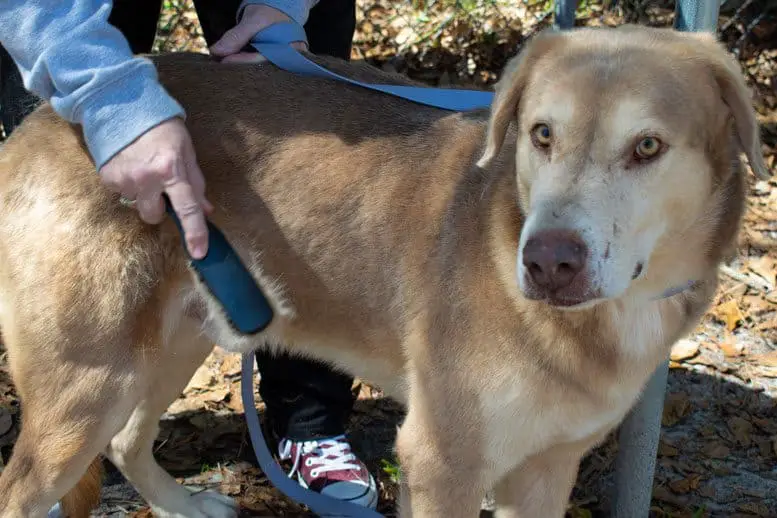Last Updated on 11/05/2020 by Veronica Jones
If you have ever owned a dog, you probably know that they bring quite a bit of mess as well as joy into your life. If you are a clean freak or suffer from allergies to dogs, you may prioritize choosing a dog who sheds less or develop tactics for dealing with shedding.
No matter what kind of dog you get, maintaining their coat will be a regular part of your life. Read on to find out how to set yourself up for success when it comes to your dog’s shedding.
Why do dogs shed?
The primary reason that dogs shed is in order to get rid of old or damaged hair. Dogs also shed seasonally in order to thin their coats in preparation for summer. Breeds with double coats like huskies and golden retrievers tend to shed the most.
Some dogs with short, shiny coats, such as Dalmatians, also shed more than other breeds in order to keep their coat clean and shiny all of the time. Dogs who grow hair instead of fur may not shed at all. Rather, they depending on their person to trim their hair when it gets too long.
What is a hypoallergenic coat?
You may see dog breeders advertising that their dogs have a hypoallergenic coat, but what does this really mean? There is no such thing as a dog who is truly hypoallergenic. People are allergic to a dog’s dander, which is produced by the saliva and the skin of every dog.
Dogs that are advertised as being hypoallergenic generally have hair rather than fur. Since the dander on the hair is not being spread around someone’s home in the same way as fur that sheds, people may be less likely to have an allergic reaction.
If you are considering purchasing a hypoallergenic breed, it is essential that you spend some time with individuals of that breed and see if they trigger a reaction. Some people who are allergic to dogs can tolerate breeds that have hair instead of fur, while other people will still have a strong reaction to these dogs.
Techniques to stop a dog from shedding
While there is no way to completely stop a dog with fur from shedding, there are techniques that you can use to reduce the amount of fur that you have to deal with. Here are some things that you can do if you would like to live with less fur in your life.
Choose a breed with hair instead of fur
Dogs come in a vast array of coat types, from long to short, fluffy to sleek. In modern times when so many dogs are kept as house pets instead of working animals, dogs with hair are becoming increasingly popular because they don’t shed and tend to be considerably more hypoallergenic than other breeds. Dogs with hair include Poodles, Maltese, Bichon Frise, Havanese, and many more. Here are some big differences between dog hair and fur.
Fur
- Stops growing at a particular length determined by the dog’s breed
- Sheds continuously throughout the year and often sheds more profusely seasonally
- May be a single or double coat. Double coats have a plush underlayer and harsher guard hairs
- May grow to different lengths at different parts of the body
Hair
- Grows continuously and must be trimmed
- Doesn’t shed hardly at all at any time of year
- Always a single coat
- Grows equally all over the body, including the face and legs
Dogs with hair require more maintenance as far as brushing, trimming, and otherwise maintaining the coat. Depending on the breed and type of hair, these dogs may be very prone to matting, in which the hair knots together into a dense mat that can’t be brushed out.
As long as these dogs are brushed regularly and trimmed as needed, they will remain healthy and happy. You won’t have to worry about these dogs shedding at any time of year.
*Beware of mixed breed dogs who have a parent with fur and a parent with hair. Breeders may say that these dogs won’t shed and have hair rather than fur, but the reality is usually a mix of hair and fur. These dogs may shed a little or a lot, but the combination of hair and fur often results in a cottony texture that is incredibly prone to matting. Popular mixed breed dogs like these include the golden retriever poodle mix and the labrador poodle mix.
Brush regularly
If you have your heart set on a dog who has fur rather than hair, you can expect some shedding. There is nothing that you can do to completely stop these dogs from shedding. However, by brushing them frequently you can make sure that the shed hair ends up where it won’t cause as much trouble.
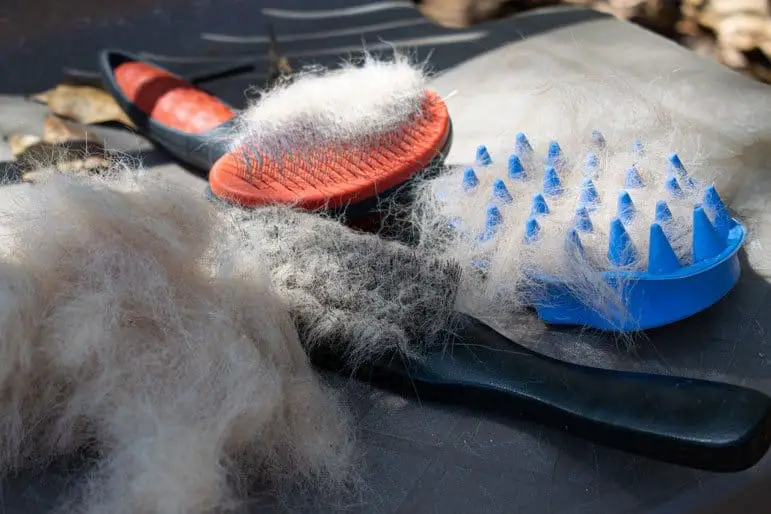
Bristle brush
A bristle brush is similar to a human’s hairbrush and is a great tool to use every day or even multiple times a day in order to free loose hair and reduce shedding throughout the day. Dogs with longer coats benefit from a bristle brush with wider spaced bristles while dogs with coarse coats may need stiffer bristles. Here’s some advice for using bristle brushes.
- Use short strokes and go with the grain. Bristle brushes work best with short, upward strokes going continuously with the grain of the hair. By the time you get to your dog’s tail, there should be a fluff-ball of loose hair built up.
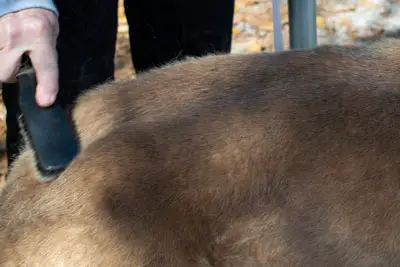
- Brush head and legs as well. Many people neglect brushing the head and legs, but they shed as well. Bristle brushes are gentle enough to brush out the head and legs.
- Use conditioner or anti-itch spray if desired. Bristle brushes are great for working conditioners and anti-itch sprays into your dog’s coat, so if you want to use one of these products it’s a good idea to spray them on before brushing or even spray them into the bristles of the brush.
Slicker brush
Slicker brushes are made with closely spaced thin wire bristles. They are designed to remove small mats and tangles and are also excellent for removing loose hair. These brushes are essential if you have a breed that has an undercoat. It is a good idea to choose a self-cleaning slicker brush, as it can be very challenging to get all of the hair out of the brush as you are working otherwise.
Slicker brushes work best when clean, so you’ll want a self-cleaning slicker brush that makes it easy for you to remove hair regularly throughout your brushing session. Here are some tips for using a slicker brush effectively.
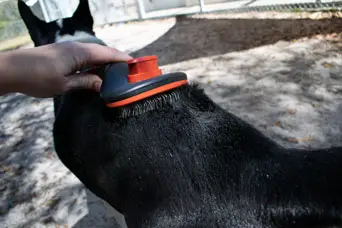 Brush in short strokes with an upward motion. Go against the grain of the hair if possible. Some coat types are more resistant to brushing against the grain than others. Brushing against the grain with a slicker brush is one of the best ways to free up hair from the root.
Brush in short strokes with an upward motion. Go against the grain of the hair if possible. Some coat types are more resistant to brushing against the grain than others. Brushing against the grain with a slicker brush is one of the best ways to free up hair from the root.- Clean the brush frequently. Slicker brushes work best when they are nearly empty, so regularly remove the hair from the brush as you are working.
- Use coconut oil to free up mats. Coconut oil is a tried-and-true groomer’s tactic for loosening small tangles and mats. It is good for your dog’s fur and skin and is fine for them to swallow as well. Keep in mind that coconut oil will need to be washed out of your dog’s coat after brushing.
Rubber nub brush
These tools have short rubber nubs that are designed to rub the fur at your dog’s skin and loosen any which is getting ready to drop. These can be useful for any breed but are especially effective for short-haired dogs. They often come as a grooming glove, which makes it easy for you to hold onto it and rub your dog down thoroughly, especially while you are giving them a bath. Using a rubber nub brush or glove isn’t always intuitive, so here are some things to keep in mind.
- Choose nubs about half the length of your dog’s coat. Nubs are only effective if they can get down to your dog’s skin, so you want them to be stiff enough to be able to push through the hair but long enough to make contact with the skin.
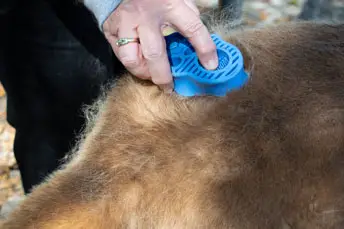 Rub in a circular motion. The brushes work to loosen the hair best when they are applied in a circular motion. This is because they turn the hair in every possible direction, giving it the highest probability of loosening.
Rub in a circular motion. The brushes work to loosen the hair best when they are applied in a circular motion. This is because they turn the hair in every possible direction, giving it the highest probability of loosening.- Clean frequently. Rubber nubl brushes work best when they are free of hair. They are easy to remove hair from, just bang them against a hard service or run water over them if using wet.
Trim the coat
Trimming won’t reduce the number of hairs that your dog’s drops, but it will reduce the overall bulk and can make it easier to loosen dead hair with brushing. Research your particular dog’s hair type before trimming or shaving the coat.
Double-coated breeds should never be trimmed or shaved because their coat is designed to regulate their body temperature and keep them warm in the winter and cool in the summer. On the other hand, single-coated breeds with longer hair may shed less in your home if they are trimmed.
Good candidates for trimming include Spaniels, Afghan Hounds, and other single-coated breeds with long coats or feathering. (Feathering is longer hair that grows on the legs, ears, and tail).
Feed a healthy diet rich in vitamins and minerals
Sometimes dogs shed excessively when they do not have adequate nutrition. For some dogs, the balanced nutrition in their kibble is not sufficient to reduce shedding. Omega-3 fatty acids promote healthy hair growth and make hair follicles strong and resistant to breakage, which can reduce shedding.
Try supplementing your dog’s diet with Omega-3 or choose a fish-based diet rich in Omega-3s and see if that helps with shedding.
Have your dog wear clothes
If your main concern is reducing your dog shedding in your house and on your furniture, one option is to have them wear clothes in the house. Relatively close-fitting clothes can trap shed hair until you take the clothes off, which can prevent it from getting all over your house.
Keep in mind that if there is too much shed hair in your dog’s clothes it can get itchy and your dog may resist wearing the clothes, so be sure to always brush your dog to get rid of as much hair as possible before putting them in clothes and always brush them thoroughly after. Only have your dog wear clothes when necessary and be sure to allow them as much time out of clothes as possible.
Ask your vet
If your dog is shedding excessively despite all of your attempts to reduce shedding, and especially if you notice that their hair is thin or balding on parts of their body, you should bring your dog to the veterinarian for a diagnosis. Hormonal issues, skin allergies, parasites, fungal infections, and even lifestyle conditions like stress and sunburn can all result in hair loss.
Your veterinarian may be able to identify why your dog is shedding profusely and prescribe something to aid them. If your dog is not on flea preventative, it is essential that you have your vet prescribed it, as scratching at fleas can dramatically increase shedding.
Techniques for cleaning up fur around your house
No matter what techniques you use to reduce your dog’s shedding unless you have a dog with hair instead of fur, you are bound to end up with some hair around your home. Here are some techniques that you can utilize to reduce the impact of shedding on your home.
- Use covers for furniture. Covering your couch, chairs, and putting an easily washable cover over your bed make it easier to remove and wash away pet hair instead of having to vacuum or lint roller upholstery.
- Get a robotic vacuum. Unless you want to pull out the vacuum cleaner several times a day to get rid of hair that sheds on the floor and can easily be spread onto upholstery or other parts of the house, get a robotic vacuum to take care of it for you.
- Use throw rugs on hard floors. Throw rugs have a tendency to absorb all of the fur on the floor so that it won’t get tracked into other parts of your home and they can easily be washed to remove hair.

